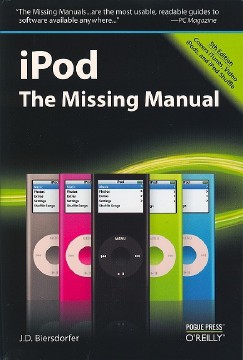
eXtensions
|
Getting the Most of out the iPod and iTunes |

Biersdorfer, J.D. iPod: The Missing Manual, Fifth Edition. O'Reilly: Sebastopol, CA. US$19.99. ISBN: 0-596-52978-3
I have been a fan of the Missing Manual series for a number of years. With the recent updates to the iPod and iTunes (version 7) an update was not unexpected. This time the update is somewhat more radical. J. D. Biersdorfer has used the opportunity for a complete overhaul.
Instead of a generally narrative approach, this version now also examines the twin technologies as a series of problems or questions for which focussed answers are provided. Users, especially those surrounded by torn gift-wrap paper, want answers, and they want them ten minutes ago.
Despite what I think is a simple device, the way the iPod interacts with iTunes is not to everyone's taste and this is where the book scores highly. Within the chapters each solution is provided within the space of one or two pages.
The high quality, glossy pages are generously illustrated either with photographs, screen shots or graphics, particularly of the iPod menus. All are in sharp colour and easy to view: no peering here. Illustrations are alternated when possible between OS X and Windows screen shots. Where needed, specific shots for the OS are provided.
The chapters are nicely organised, beginning sensibly with an Introduction to help even the technically-challenged to cope. its title, "Meet the iPod: Out of the Box and into your Ears in 15 minutes," gives an idea of the approach that Biersdorfer takes, particularly when she adds, "You won't get bogged down in acres of print here."
As someone who teaches writing to engineers, with their years of reading unnaturally written textbooks it can be an uphill task for them to consider the basics. Biersdofer gets to the essence of things. In this opening, note that the current range, including a full explanation of the shuffle, are all included.
Following the Introduction, there is a chapter on basic functions of the iPods, concentrating in the main on the menu systems of those iPods with screens. With the ability to dip into the text where we want, the menu graphics are particularly effective here.
The following three chapters concentrate on the recently updated iTunes. Although some are not fans of this application, I recognise (and Biersdorfer shows) that the operations of the iPods are so closely integrated with iTunes that, although it is possible to run other software, the best performance comes when iTunes is used.
What I could not find mentioned is the way to use the iPod with Linux and here, a third party application (such as Yamipod) is the only alternative.
Chapters 3 and 4 are really the core of the book for me: showing how powerful iTunes is as a tool to manage the music and the iPod. Chapter 5 is less useful for us here in Thailand as most of the iTunes shop is off-limits owing to the restrictions the copyright holders put on their music, movies and TV shows.
Never mind, there are still the independents; and if that is not enough we have podcasts; and we can always make our own. Biersdorfer looks at several other sources and alternatives such as podcasts, as well as converting movies, or putting our own movies into iTunes and those iPods that support this medium in the sixth chapter, on videos, and follows this with Chapter 7 on using photographs.
As I have found, viewing such media on an iPod is not impossible despite the small screen, but this book also outlines a number of other (external) viewing possibilities and the hardware needed to make this happen.
The iPod is more than just a music and video player. I dumped my Palm partly as I found that all my contact addresses and calendars, plus text files could be put on the iPod; and the editor of the Database uses his for recording interviews with a suitable attachment: details of these tricks are in Chapter 8.
It is all very well to put the sound in to the iPod, but how about getting it out? Biersdorfer looks at several ways that this might be done apart from the Apple white earbuds. She examines car and home stereo systems (including Airport Express, the wifi way to hifi) and other speaker output. This chapter concludes with online resources.
As with any manual, there needs to be a fixit section and the tenth chapter examines fault-finding and repairs. The final chapter looks at some more advanced technologies that can complement iPod use, including 3rd party headphones, the Nike connector and making your own podcast.
Although Apple has online documentation, this book will help anyone get far more out of the iPod. If you are buying an ipod as a present or as a gift to yourself, consider this Missing Manual too.
Look for my reports from the MacWorld conference and show in San Francisco.

For further information, e-mail to
Back to
eXtensions
To
eXtensions: 2004-05
To
eXtensions: Year Two
To
eXtensions: Year One
To
eXtensions: Book Reviews
Back to homepage